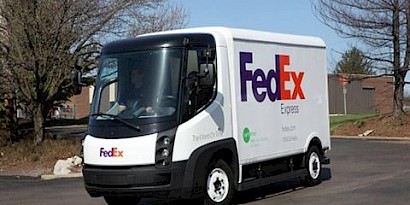How FedEx plans to become carbon neutral by 2040
 If you get a FedEx delivery in some Californian cities later this year, it might show up in a new electric delivery vehicle—and come down the sidewalk in a new electric pallet that helps couriers carry heavier loads. The company will be receiving 500 of the vehicles, from GM’s BrightDrop, as one part of a larger push to make all pickup and delivery vehicles zero emissions. By 2040, FedEx says it plans to become carbon neutral.
If you get a FedEx delivery in some Californian cities later this year, it might show up in a new electric delivery vehicle—and come down the sidewalk in a new electric pallet that helps couriers carry heavier loads. The company will be receiving 500 of the vehicles, from GM’s BrightDrop, as one part of a larger push to make all pickup and delivery vehicles zero emissions. By 2040, FedEx says it plans to become carbon neutral.
“The Paris climate accord is calling for this to be done by 2050,” says Mitch Jackson, chief sustainability officer for FedEx Corp. “We looked at it and felt that we could do it by 2040. And if we felt that way, it was incumbent upon us to do that.” Amazon has the same goal.
FedEx has been using some electric vehicles, at a small scale, for more than a decade. But the technology is finally ready for widespread use, Jackson says. “We feel that the vehicles now are being developed to meet the operational requirements for us on range,” he says. “We also feel we’ve hit that inflection point with respect to scalability.” The vehicles can also save operational costs, since electricity is cheaper than fuel and they require less maintenance.
The company is scaling up the necessary infrastructure now—over the last year, for example, it installed 500 charging stations in California. (It’s also transitioning to more renewable electricity in its facilities.) By 2025, it plans to choose an electric option for half of its new pickup and delivery vehicle purchases. By 2030, 100% of its vehicle purchases will be EVs. By 2040, the entire fleet will be electric. In some cities, the company may also begin to make more use of alternatives to trucks or vans, such as electric cargo bikes.
Outside of cities, long-haul trucking is transitioning more slowly than delivery vehicles, though FedEx has a small number of Tesla electric semis on order and expects to begin shifting to other new technology, such as trucks that run on green hydrogen. Some current transportation happens on freight trains, which have a far lower carbon footprint than trucks.
The largest part of FedEx’s carbon footprint, though, comes from the jet fuel it uses on planes. The company has spent years working on efficiency improvements to save fuel, but they acknowledge that, as Jackson says, “efficiency improvement will not get us to a zero-carbon world.” It’s also investing in some alternative fuels, such as a biofuel made from logging waste that will begin to be used in planes in the Bay Area later this year, and it sees the potential for other technology, such as synthetic fuel made from captured CO2. But those technologies aren’t ready to be scaled up now. “The issue is the time frame,” he says. “The question is, will sustainable aviation fuels be here in sufficient quantities for the aviation industry in the near term?”
As it works on direct emissions, the company is also pouring $100 million into a new research center at Yale University that will study new ways to capture more carbon through nature, from increasing photosynthesis in plants to capturing CO2 through mineral weathering. The aim is to be able to offset all of its emissions from aviation until the industry can find solutions to truly eliminate emissions.
You can return to the main Market News page, or press the Back button on your browser.

